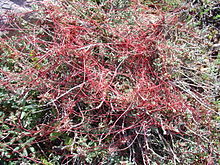
Summary
Cuscuta epithymum (dodder, lesser dodder, hellweed, strangle-tare) is a parasitic plant assigned to the family Cuscutaceae or Convolvulaceae, depending on the taxonomy. It is red-pigmented, not being photosynthetically active. It has a filiform habit, like a group of yarns. Its leaves are very small, like flakes. Its flowers, disposed in little glomerules, have a white corolla, with the androecium welded to the corolla.
| Cuscuta epithymum | |
|---|---|

| |
| Scientific classification | |
| Kingdom: | Plantae |
| Clade: | Tracheophytes |
| Clade: | Angiosperms |
| Clade: | Eudicots |
| Clade: | Asterids |
| Order: | Solanales |
| Family: | Convolvulaceae |
| Genus: | Cuscuta |
| Species: | C. epithymum
|
| Binomial name | |
| Cuscuta epithymum | |
| Synonyms | |
|
Lepimenes epithymum (L.) Raf.[3] | |
In Eurasia, this species of dodder would often attach itself to the Conehead thyme (Thymus capitatus), taking on the plant's pungency and from whence it also derived its host's Arabic name, al-ṣaʿitrah.[6] During medieval times, dodder was often used as a medicinal cure in treating depression, but causes thirst and dryness of the mouth when consumed.[6]
References edit
- ^ "Systema vegetabilium ed 13". Linnean Collections. 1774. p. 140. Retrieved 14 July 2018.
- ^ "IPNI Cuscuta epithymum". International Plant Name Index. Retrieved 14 July 2018.
- ^ Govaerts, R.; et al. (2018). "Plants of the World online Cuscuta epithymum". Board of Trustees of the Royal Botanic Gardens, Kew. Retrieved 14 July 2018.
- ^ "APNI Cuscuta epithymum". Australian Plant Name Index. Retrieved 14 July 2018.
- ^ Linnaeus, C. (1753) Species Plantarum 1: 124
- ^ a b Amar, Z.; Serri, Yaron (2004). The Land of Israel and Syria as Described by al-Tamimi – Jerusalem Physician of the 10th Century (in Hebrew). Ramat-Gan. pp. 70–72 (note 230). ISBN 965-226-252-8.
{{cite book}}: CS1 maint: location missing publisher (link) -- (OCLC 607157392)
External links edit
- Media related to Cuscuta epithymum at Wikimedia Commons
- Data related to Cuscuta epithymum at Wikispecies


